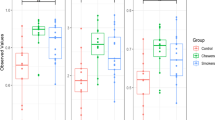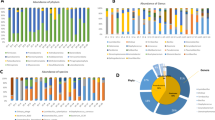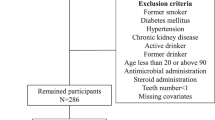Abstract
The present investigation is aiming to report the oral bacterial composition of smokeless tobacco (SLT) users and to determine the influence of SLT products on the healthy Indian population. With the aid of the V3 hypervariable region of the 16S rRNA gene, a total of 8,080,889 high-quality reads were clustered into 15 phyla and 180 genera in the oral cavity of the SLT users. Comparative analysis revealed a more diverse microbiome where two phyla and sixteen genera were significantly different among the SLT users as compared to the control group (p-value < 0.05). The prevalence of Fusobacteria-, Porphyromonas-, Desulfobulbus-, Enterococcus-, and Parvimonas-like genera among SLT users indicates altered bacterial communities among SLT users. Besides, the depletion of health-compatible bacteria such as Lactobacillus and Haemophilus also suggests poor oral health. Here, the majority of the altered genera belong to Gram-negative anaerobes that have been reported for assisting biofilm formation that leads in the progression of several oral diseases. The PICRUSt analysis further supports the hypothesis where a significant increase in the count of the genes involved in the metabolism of nitrogen, amino acids, and nicotinate/nicotinamide was observed among tobacco chewers. Moreover, this study has a high significance in Indian prospects where the SLT consumers are prevalent but we are deficient in information on their oral microbiome.






Similar content being viewed by others
Data Availability
Data can be made available to an individual upon sending an email to the corresponding author. Raw data is also linked with this manuscript.
References
Sinha DN, Gupta PC, Kumar A, Bhartiya D, Agarwal N, Sharma S, Singh H, Parascandola M, Mehrotra R (2018) The poorest of poor suffer the greatest burden from smokeless tobacco use: a study from 140 countries. Nicotine Tob. Res. 20:1529–1532
Siddiqi K, Islam Z, Khan Z, Siddiqui F, Mishu M et al (2019) Identification of policy priorities to address the burden of smokeless tobacco in Pakistan: a multi method analysis. Nicotine Tob. Res. 29:ntz163
WHO Factsheet India 2018. Received from regional office of South East Asia.
Rodgman A, Perfetti TA (2009) The chemical components identified in tobacco and tobacco smoke prior to 1954: a chronology of classical chemistry. Beitr. Tabakforsch. Int. 23:277–333
Vishwakarma A, Verma D (2020) Exploring the microbiome of smokeless tobacco. In: Chaudhary, Raj, Verma, Akhter (eds) Microorganisms for Sustainable Environment and Health. Elsevier, Amsterdam, pp 167–178
Han J, Sanad YM, Deck J, Sutherland JB, Li Z, Walters MJ (2016) Bacterial populations associated with smokeless tobacco products. Appl. Environ. Microbiol. 82:6273–6283
Law AD, Fisher C, Jack A, Moe LA (2016) Tobacco, microbes, and carcinogens: correlation between tobacco cure conditions, tobacco-specific nitrosamine content, and cured leaf microbial community. Microb. Ecol. 72:120–129
Halboub E, Al-Akhali MS, Alamir AH, Homeida HE, Baraniya D et al (2020) Tongue microbiome of smokeless tobacco users. BMC Microbiol. 20:201
National cancer institute and centers for disease control and prevention (2014) Smokeless tobacco and public health: a global perspective. U.S. Department of health and human services, Centers for disease control and prevention and National Institutes of Health, National cancer institute. NIH Publication No, Bethesda, MD, pp 14–7983
Miluna S, Rostoka D, Skadioo I, Reinis A, Priedite V, Koka R, Lauva D, Krojea J (2017) The oral microbiome of smokeless tobacco users in Latvia. Proc. Latv. Acad. Sci. 71:33–37
Ganesan SM, Joshi V, Fellows M, Dabdoub SM, Nagaraja HN (2017) A tale of two risks: smoking diabetes and the subgingival microbiome. ISME J 11:2075–2089
Bornigen D, Ren B, Pickard R, Li J, Ozer E, Hartmann EM, Xiao W, Tickle T, Rider J, Gevers D, Franzosa EA (2017) Alterations in oral bacterial communities are associated with risk factors for oral and oropharyngeal cancer. Sci. Rep. 7:17686
Verma D, Srivastava A, Garg PK, Akhter Y, Dubey AK, Mishra SD, Deo SVS (2020) Taxonomic profiling and functional characterization of the healthy human oral bacterial microbiome from the north Indian urban sub-population. Arch. Microbiol. https://doi.org/10.1007/s00203-020-02084-7
Sievers F, Wilm A, Dineen D, Gibson TJ, Karplus K, Li W, Lopez R, McWilliam H, Remmert M, Söding J, Thompson JD, Higgins DG (2011) Fast, scalable generation of high-quality protein multiple sequence alignments using Clustal Omega. Molecular Sys Biol 7:539
Edgar RC, Haas BJ, Clemente JC, Quince C, Knight R (2011) UCHIME improves sensitivity and speed of chimera detection. Bioinformatics 27:2194–2200
Edgar R (2013) UPARSE: Highly accurate OTU sequences from microbial amplicon reads. Nat. Methods 10:996–998
Bik EM, Eckburg PB, Gill SR, Nelson KE, Purdom EA (2006) Molecular analysis of the bacterial microbiota in the human stomach. Proc. Natl. Acad. Sci. U. S. A. 103:732–737
Parks DH, Tyson GW, Hugenholtz P, Beiko RG (2014) STAMP: Statistical analysis of taxonomic and functional profiles. Bioinformatics 30:3123–3124
Langille MG, Zaneveld J, Caporaso JG (2013) Predictive functional profiling of microbial communities using 16S rRNA marker gene sequences. Nat. Biotechnol. 31:814–821
Prodan A, Tremaroli V, Brolin H, Zwinderman AH, Nieuwdorp M, Levin E (2020) Comparing bioinformatic pipelines for microbial 16S rRNA amplicon sequencing. PLoS One 15:e0227434
Bokulich NA, Kaehler BD, Rideout JR, Dillon M, Bolyen E, Knight R, Huttley GA, Gregory Caporaso J (2018) Optimizing taxonomic classification of marker-gene amplicon sequences with QIIME 2’s q2-feature-classifier plugin. Microbiome 6:90
Liu M, Jin J, Pan H, Feng J, Cerniglia CE, Yang M, Chen H (2016) Effect of smokeless tobacco products on human oral bacteria growth and viability. Anaerobe 42:152–161
Camelo-Castillo AJ, Mira A, Pico A et al (2015) Subgingival microbiota in health compared to periodontitis and the influence of smoking. Front. Microbiol. 6:119
Mason MR, Preshaw PM, Nagaraja HN, Dabdoub SM, Rahman A, Kumar PS (2015) The subgingival microbiome of clinically healthy current and never smokers. ISME J 9:268–272
Valles Y, Inman CK, Peters BA (2018) Types of tobacco consumption and the oral microbiome in the United Arab Emirates Healthy Future (UAEHFS) Pilot Study. Sci. Rep. 8:11327
Verma D, Garg PK, Dubey AK (2018) Insights into the human oral microbiome. Arch. Microbiol. 200:525–540
Jenkinson HF, Lamont RJ (2005) Oral microbial communities in sickness and in health. Trends Microbiol. 13:589–595
Gupta S, Gupta R, Sinha DN, Mehrotra R (2018) Relationship between type of smokeless tobacco and risk of cancer: a systematic review. Indian J. Med. Res. 148:56–76
Lundmark A, Hu Y, Huss M, Johannsen G, Andersson AF, Yucel-Lindberg T (2019) Identification of salivary microbiota and its association with host inflammatory mediators in periodontitis. Front. Cell, Microbiol 9:216
Huang C, Shi G (2019) Smoking and microbiome in oral, airway, gut and some systemic diseases. J. Transl. Med. 17:225
Ho D, Ang G, Er C (2018) An unusual presentation of Parvimonas micra infective endocarditis. Cureus 10:e3447
Tindall B, Euzeby J (2006) Proposal of Parvimonas gen. nov. and Quatrionicoccus gen. nov. as replacements for the illegitimate, prokaryotic, generic names Micromonas Murdoch and Shah 2000 and Quadricoccus Maszenan et al 2002, respectively. Int. J. Syst. Evol. Microbiol. 56:2711–2713
Murphy EC, Frick IM (2013) Gram-positive anaerobic cocci – commensals and opportunistic pathogens. FEMS Microbiol. Rev. 37:520–553
Siqueira Jr JF, Rocas IN (2006) Catonella morbi and Granulicatella adiacens: new species in endodontic infections. Oral Surg. Oral Med. Oral Pathol. Oral Radiol. Endod. 102:259–264
Carlier JP, Kouas G, Han XY (2007) Moryella indoligenes gen. nov., sp. nov., an anaerobic bacterium isolated from clinical specimens. Int. J. Syst. Evol. Microbiol. 57:725–729
Costalonga M, Herzberg MC (2014) The oral microbiome and the immunobiology of periodontal disease and caries. Immunol. Lett. 162:22–38
Chen X, Winckler B, Lu M, Cheng H, Yuan Z, Yang Y (2015) Oral microbiota and risk for esophageal squamous cell carcinoma in a high- risk area of China. PLoS One 10:e0143603
Komiyama EY, Lepesqueur LSS, Yassuda CG, Samaranayake LP, Parahitiyawa NB, Balducci I (2016) Enterococcus species in the oral cavity: prevalence, virulence factors and antimicrobial susceptibility. PLoS One 11:e0163001
Hung WL, Wade WG, Boden R, Kelly DP, Wood AP (2011) Facultative methylotrophs from the human oral cavity and methylotrophy in strains of Gordonia, Leifsonia, and Microbacterium. Arch. Microbiol. 193:407–417
Tsuzukibashi O, Uchibori S, Kobayashi T, Saito M, Umezawa K, Ohta M, Shinozaki-Kuwahara N (2015) A selective medium for the isolation of Microbacterium species in oral cavities. J. Microbiol. Methods 116:60–65
Romanowska I, Kwapisz E, Mitka M, Bielecki S (2010) Isolation and preliminary characterization of a respiratory nitrate reductase from hydrocarbon-degrading bacterium Gordonia alkanivorans S7. J. Ind. Microbiol. Biotechnol. 37:625–629
Zhang D, Li W, Huang X, Wen Q, Liu M (2013) Removal of ammonium in surface water at low temperature by a newly isolated Microbacterium sp. strain SFA13. Bioresour. Technol. 137:147–152
Fisher MT, Bennett CB, Hayes A, Kargalioglu Y, Knox BL, Xu D, Muhammad-Kah R, Gaworski CL (2012) Sources of and technical approaches for the abatement of tobacco specific nitrosamine for mationin moist smokeless tobacco products. Food Chem. Toxicol. 50:942–948
Wei X, Deng X, Cai D, Ji Z, Wang C, Yu J, Li J, Chen S (2014) Decreased tobacco-specific nitrosamines by microbial treatment with Bacillus amyloliquefaciens DA9 during the air-curing process of burley tobacco. J. Agric. Food Chem. 62:12701–12706
Junemann S, Prior K, Szczepanowski R (2012) Bacterial community shift in treated periodontitis patients revealed by Ion Torrent 16S rRNA gene amplicon sequencing. PLoS One 7:e41606
Chen WP, Chang SH, Tang CY, Liou ML, Tsai SJ, Lin YL (2018) Composition analysis and feature selection of the oral microbiota associated with periodontal disease. Biomed. Res. Int. 2018:3130607
Greabu M, Totan A, Miricescu D, Radulescu R, Virlan J, Calenic B (2015) Hydrogen sulfide, oxidative stress and periodontal diseases: a concise review. Antioxid (Basel) 5:3
Al-hebshi N, Alharbi F, Mahri M, Chen T (2017) Differences in the bacteriome of smokeless tobacco products with different oral carcinogenicity: compositional and predicted functional analysis. Genes 8:106
Hyde ER, Andrade F, Vaksman Z, Parthasarathy K, Jiang H, Parthasarathy DK (2014) Metagenomic analysis of nitrate-reducing bacteria in the oral cavity: implications for nitric oxide homeostasis. PLoS One 9:e88645
Nasrin S, Chen G, Watson CJW, Lazarus P (2020) Comparison of tobacco-specific nitrosamine levels in smokeless tobacco products: high levels in products from Bangladesh. PLoS One 15:e0233111
Guerrero-Preston R, Godoy-Vitorino F, Jedlicka A, Rodríguez-Hilario A, Gonzalez H, Bondy J (2016) 16S rRNA amplicon sequencing identifies microbiota associated with oral cancer, human papilloma virus infection and surgical treatment. Oncotarget 7:51320–51334
Lim Y, Fukuma N, Totsika M, Kenny L, Morrison M, Punyadeera C (2018) The performance of an oral microbiome biomarker panel in predicting oral cavity and oropharyngeal cancers. Front. Cell. Infect. Microbiol. 8:267
Segata N, Haake SK, Mannon P (2012) Composition of the adult digestive tract bacterial microbiome based on seven mouth surfaces, tonsils, throat and stool samples. Genome Biol. 13R42:1–18
Bolourian A, Mojtahedi Z (2018) Streptomyces, shared microbiome member of soil and gut, as ‘old friends’ against colon cancer. FEMS Microbiol. Ecol. 1:94
Li Y, Tan X, Zhao X, Xu Z, Dai W, Duan W, Huang S, Zhang E, Liu J, Zhang S, Yin R, Shi X, Lu Z, Pan Y (2020) Composition and function of oral microbiota between gingival squamous cell carcinoma and periodontitis. Oral Oncol. 107:104710
Bhushan B, Yadav AP, Singh SB (2019) Diversity and functional analysis of salivary microflora of Indian Antarctic expeditionaries. J. Oral Microbiol. 11:1581513
Wu J, Peters BA, Dominianni C, Zhang Y, Pei Z (2016) Cigarette smoking and the oral microbiome in a large study of American adults. ISME J 10:2435–2446
Code availability
Not applicable
Funding
The investigation is financially supported by SERB, New Delhi (File No. SB/YS/LS-102/2014), and UGC-BSR (F 30.442/2018/BSR).
Author information
Authors and Affiliations
Corresponding author
Ethics declarations
Ethics approval
The protocol of the study was approved by the Institutional Ethical Committee, Netaji Subhas University of Technology, New Delhi (NSUT), as well as the All India Institute of Medical Sciences (AIIMS), New Delhi (Ref No. IEC/NP 166/2014/ RP-14/2014).
Consent to participate
A signed consent was taken from all the participants.
Consent for publication
On acceptance of the manuscript, the copyrights will be transferred to the publisher.
Conflict of interest
The authors declare no competing interests.
Supplementary Information
ESM 1
Supplementary fig. 1. The PICRUSt analysis at tier I, II reveals significant differences among the genes involved in human diseases, and cellular processes (a), the metabolism of amino acids, xenobiotics (b). Supplementary fig. 2. Beta diversity analysis among SLT users (HTC) and non-users (HI) using weighted Unifrac (quantitative) phylogenetic metric pairing method showing less difference at the genera levels. (PDF 356 kb)
ESM 2
(DOCX 45 kb)
ESM 3
(XLSX 82 kb)
Rights and permissions
About this article
Cite this article
Srivastava, A., Mishra, S. & Verma, D. Characterization of Oral Bacterial Composition of Adult Smokeless Tobacco Users from Healthy Indians Using 16S rDNA Analysis. Microb Ecol 82, 1061–1073 (2021). https://doi.org/10.1007/s00248-021-01711-0
Received:
Accepted:
Published:
Issue Date:
DOI: https://doi.org/10.1007/s00248-021-01711-0




